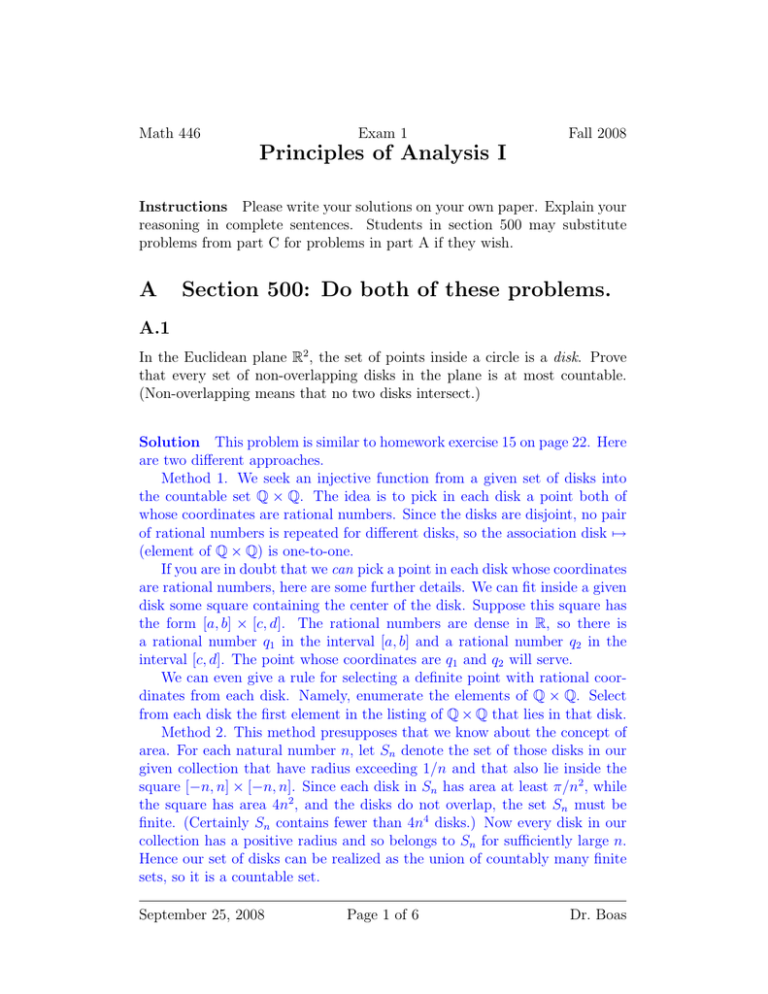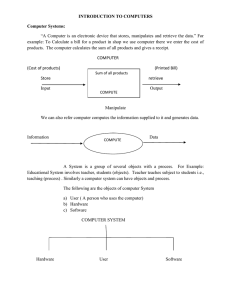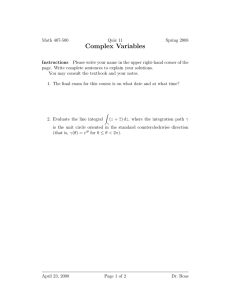Principles of Analysis I
advertisement

Math 446
Exam 1
Fall 2008
Principles of Analysis I
Instructions Please write your solutions on your own paper. Explain your
reasoning in complete sentences. Students in section 500 may substitute
problems from part C for problems in part A if they wish.
A
Section 500: Do both of these problems.
A.1
In the Euclidean plane R2 , the set of points inside a circle is a disk. Prove
that every set of non-overlapping disks in the plane is at most countable.
(Non-overlapping means that no two disks intersect.)
Solution This problem is similar to homework exercise 15 on page 22. Here
are two different approaches.
Method 1. We seek an injective function from a given set of disks into
the countable set Q × Q. The idea is to pick in each disk a point both of
whose coordinates are rational numbers. Since the disks are disjoint, no pair
of rational numbers is repeated for different disks, so the association disk 7→
(element of Q × Q) is one-to-one.
If you are in doubt that we can pick a point in each disk whose coordinates
are rational numbers, here are some further details. We can fit inside a given
disk some square containing the center of the disk. Suppose this square has
the form [a, b] × [c, d]. The rational numbers are dense in R, so there is
a rational number q1 in the interval [a, b] and a rational number q2 in the
interval [c, d]. The point whose coordinates are q1 and q2 will serve.
We can even give a rule for selecting a definite point with rational coordinates from each disk. Namely, enumerate the elements of Q × Q. Select
from each disk the first element in the listing of Q × Q that lies in that disk.
Method 2. This method presupposes that we know about the concept of
area. For each natural number n, let Sn denote the set of those disks in our
given collection that have radius exceeding 1/n and that also lie inside the
square [−n, n] × [−n, n]. Since each disk in Sn has area at least π/n2 , while
the square has area 4n2 , and the disks do not overlap, the set Sn must be
finite. (Certainly Sn contains fewer than 4n4 disks.) Now every disk in our
collection has a positive radius and so belongs to Sn for sufficiently large n.
Hence our set of disks can be realized as the union of countably many finite
sets, so it is a countable set.
September 25, 2008
Page 1 of 6
Dr. Boas
Math 446
Exam 1
Fall 2008
Principles of Analysis I
A.2
Give an example of a sequence (an ) of real numbers such that
inf an = 1,
n
lim inf an = 2,
n→∞
lim sup an = 3,
n→∞
and
sup an = 4.
n
Solution There are many examples. Perhaps the simplest example is the
sequence 1, 4, 2, 3, 2, 3, . . . , with the numbers 2 and 3 repeating. A popular
correct answer is the following:
(
2 − n1 , if n is odd,
an =
3 + n2 , if n is even.
If you are leery of piecewise defined sequences, you could use a more elaborate
example like the following:
1
2n
n
an =
5 + (−1) 1 +
.
2
n!
B
Section 500 and Section 200: Do two of
these problems.
B.1
The producer of the television show “The Biggest Loser” proposes to define a
metric d on the set of Texas A&M students as follows: d(x, y) = the maximum
weight in pounds of students x and y if x and y are different students, and
d(x, y) = 0 if x and y are the same student. Does this proposed d satisfy all
the properties of a metric? Explain.
Solution It is immediate from the indicated definition that d(x, y) is (i) nonnegative, (ii) equal to 0 if and only if x = y, and (iii) symmetric. What needs
to be checked is the triangle inequality:
d(x, y) ≤ d(x, z) + d(z, y).
September 25, 2008
Page 2 of 6
Dr. Boas
Math 446
Exam 1
Fall 2008
Principles of Analysis I
Let’s use the ad hoc notation that x̄ denotes the weight of student x;
thus d(x, y) = max{x̄, ȳ} when x 6= y. For any d satisfying properties (i),
(ii), and (iii), the triangle inequality is a triviality in the special case that
x = y or y = z or z = x. Therefore we need only consider the case that x, y,
and z are all distinct. In that case,
d(x, y) = max{x̄, ȳ} ≤ x̄ + ȳ
(the max of positive quantities is less than the sum)
≤ max{x̄, z̄} + max{ȳ, z̄}
(a number does not exceed its max with another number)
= d(x, z) + d(y, z).
Thus the triangle inequality holds.
Instead of using the preceding trickery, you could argue in a more pedestrian way as follows. Since both sides of the triangle inequality are symmetric
in x and y, there is no loss of generality in assuming that x̄ ≤ ȳ. In that
case, the left-hand side of the triangle inequality equals ȳ (still under the
assumption that x, y, and z are all distinct). But ȳ ≤ d(y, z), so we deduce
that d(x, y) ≤ d(y, z), and a fortiori d(x, y) ≤ d(x, z) + d(y, z).
Another popular method was to consider cases: x̄ ≤ ȳ ≤ z̄, x̄ ≤ z̄ ≤ ȳ,
and z̄ ≤ x̄ ≤ ȳ. At first sight, it appears that there should be six cases, but
you can reduce to three cases by symmetry considerations.
Consequently, the proposed d does satisfy all the properties of a metric.
B.2
Constance misremembers the definition of continuity of a function f : R → R
at a point x as the following statement:
For every positive and for every positive δ we have the inequality
|f (x) − f (y)| < whenever |x − y| < δ.
What well-known set of functions does Constance’s property actually characterize? Explain.
Solution Constance’s property characterizes the constant functions!
It is obvious that every constant function f does satisfy the property, since
then |f (x) − f (y)| = 0 < for every positive . Conversely, suppose f is a
September 25, 2008
Page 3 of 6
Dr. Boas
Math 446
Exam 1
Fall 2008
Principles of Analysis I
function satisfying Constance’s property. Let y be an arbitrary point. Taking
δ equal to |x − y| + 1 in Constance’s property shows that |f (x) − f (y)| < for every positive . The only non-negative real number smaller than every
positive number is 0, so |f (x) − f (y)| = 0. Thus f (y) is equal to f (x)
whatever y is, so f is a constant function.
B.3
The irrational number e/π is approximately equal to 0.865255979432. Does
the number e/π belong to the Cantor set? Explain how you know.
Solution The first step of the construction of the Cantor set removes the
points between 1/3 and 2/3. The second step removes the points between
1/9 and 2/9 and also the points between 7/9 and 8/9. Since
7
9
= 0.777 . . . < 0.865255979432 . . . < 0.888 . . . = 89 ,
the number e/π is removed at the second stage. Thus the number e/π is not
in the Cantor set.
B.4
Let (x(n) )∞
n=1 be a sequence in the space `2 of square-summable sequences of
real numbers. Thus
X
1/2
∞
(n)
(n)
(n) 2
(n)
(n)
x = (x1 , x2 , . . . ),
and
kx k2 =
|xk |
.
k=1
Eleanor conjectures that x(n) → 0 in the normed space `2 if and only if
(n)
xk → 0 in R for every k. Either prove or disprove Eleanor’s conjecture.
(n)
(n)
Solution Since |xk | ≤ kx(n) k2 , it is true that xk → 0 for every k whenever kx(n) k2 → 0. The converse, however, is false. For instance, if x(n) is the
nth “unit basis vector” (0, . . . , 0, 1, 0, . . . ) having a 1 in the nth position and
(n)
0 elsewhere, then xk → 0 for each k, yet kx(n) k2 = 1 6→ 0. This example is
actually in the textbook at the bottom of page 47.
September 25, 2008
Page 4 of 6
Dr. Boas
Math 446
Exam 1
Fall 2008
Principles of Analysis I
C
Section 200: Do both of these problems.
C.1
For which values of p does the parallelogram law
kx + yk2p + kx − yk2p = 2kxk2p + 2kyk2p
hold for all elements x and y in the sequence space `p ? Explain.
Solution The parallelogram law holds if and only if p = 2.
That the law does hold when p = 2 follows from a computation:
kx +
yk22
+ kx −
yk22
=
=
∞
X
j=1
∞
X
2
|xj + yj | +
∞
X
|xj − yj |2
j=1
(x2j
j=1
∞
X
=2
+ 2xj yj +
yj2 )
+
∞
X
(x2j − 2xj yj + yj2 )
j=1
(x2j + yj2 ) = 2kxk22 + 2kyk22 .
j=1
To see that the law fails when p 6= 2 requires a counterexample. Take x
and y equal to the first two “unit basis vectors”: x = (1, 0, 0, . . .) and y =
(0, 1, 0, 0, . . .). Then kx + yk2p = kx − yk2p = (1p + 1p )2/p = 22/p , so the lefthand side of the parallelogram law equals 2 · 22/p . On the other hand, the
right-hand side of the parallelogram law equals 2 · 1 + 2 · 1 = 2 · 2. Evidently
2 · 22/p and 2 · 2 are different when p 6= 2.
Remark We know that a norm k·k generates a metric via d(x, y) = kx−yk,
but not every metric arises from a corresponding
norm. Analogously, an inner
p
product h·, ·i generates a norm via kxk = hx, xi, but not every norm arises
from a corresponding inner product. It turns out that a norm does arise from
some inner product precisely when the norm satisfies the parallelogram law.
September 25, 2008
Page 5 of 6
Dr. Boas
Math 446
Exam 1
Fall 2008
Principles of Analysis I
C.2
Alfie proposes the following “proof” that the real numbers between 0 and 1
form a countable set (a statement that we know to be false):
The decimals that have exactly one non-zero digit form a countable set; the decimals that have exactly two non-zero digits form
a countable set; and so on. The set of all decimals is therefore the
union of countably many countable sets, hence is itself a countable set.
Pinpoint the fatal error in Alfie’s argument.
Solution Alfie’s fatal oversight is that there are lots of real numbers having
infinitely many non-zero decimal digits, such as 0.101010 . . . and π − 3. Alfie
has counted only the decimals having a finite number of non-zero digits, and
these constitute a (proper) subset of the rational numbers.
September 25, 2008
Page 6 of 6
Dr. Boas






